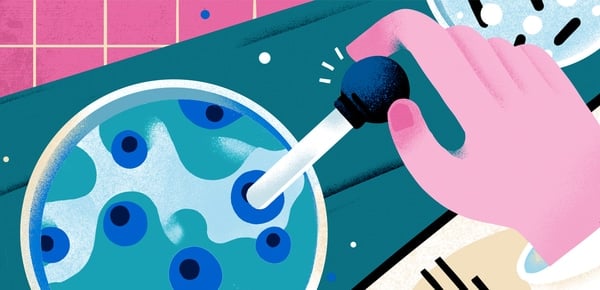Newsletter Signup - Under Article / In Page
"*" indicates required fields
Overfishing is a global issue that negatively impacts the ecosystem and our access to fish protein. One solution to overfishing is producing fish products in the lab from harvested animal cells. This can help feed the world while using up fewer resources and without endangering wild fish populations.
As the world’s population continues to grow, so does its appetite for seafood. This increasing demand threatens many fish stocks that are already under pressure from overfishing and other human activities. According to the United Nations Food and Agriculture Organization, 34.2% of fisheries are overfished, which are responsible for 22.7% of the world’s seafood supply.
Innovators in the cultured food space are creating sustainable alternatives to traditional meat and fish products to reduce our impact on the environment. One such innovator is German start-up Bluu Seafood — Europe’s first lab-grown fish company. Their aim is to create healthy and sustainable fish products to secure a future supply of fish protein.
Beyond sustainability, the advantages of lab-grown fish include its high nutritional value and the absence of contaminants such as dioxins and mercury that are typically found in wild-caught fish. And compared to the fish-processing industry, the production of cultured fish saves resources, having a significantly lower CO2 footprint as well as water and energy usage.
To learn more about how such fish products are produced and how they can have a positive impact on our marine ecosystems, we spoke with Sebastian Rakers, co-founder and CEO of Bluu Seafood. Rakers is a marine biotechnologist that has spent more than a decade working with fish cells and applied science, launching Bluu Seafood — then Bluu GmbH — in 2020.
How does Bluu Seafood develop its cultured fish products?
Culturing fish starts with taking a small sample of fish tissue that contains different populations of stem cells. Out of the isolated stem cells our scientists create what is called an “immortalized cell line.” This cell line can be used over and over again without the need to go back to the animal.
The cells are then grown in a bioreactor, which provides a sterile environment that enables the same development processes that take place inside an animal’s body to occur. It provides cells with the heat and nutrients (water, protein, carbohydrates, fats, vitamins and minerals) they need to reproduce and grow.
The result is a large amount of fish cells. These include muscle, fat and tissue cells that are identical to the cells growing in a living animal, providing the same nutrients as wild caught or farmed fish. We then use these fish cells in combination with other ingredients such as plant-based proteins to create products such as fish fingers or fish balls. In the medium term, we will also be able to produce more complex products such as salmon fillet, which will be grown on 3D scaffolds made out of plant material to create an optimal structure.
Can you tell us some of the main differences between cultured fish and cultured beef or chicken products?
In essence the process is a similar one although there are a few differences. First, working with fish cells is more energy efficient as fish cells can be cultured at room temperature, which saves on energy costs, while mammalian cells need to be maintained at 37°C.
Second, fish cells are more robust and tolerant of varying oxygen levels than are mammalian cells, which is an advantage for bioreactors with low oxygen levels.
Third, the meat structure of fish is significantly less complex than that of mammalian meat, as it mostly consists of muscle tissue, which makes the production process simpler and more cost effective.
With climate change and overfishing, there is pressure on global fisheries and the marine ecosystem. Do you anticipate that cultured fish products can help consumers move away from wild-caught fish?
We are destroying our oceans. Over 90% of wild fisheries are classified as overfished or harvested at maximum capacity. Also, more than three trillion marine animals are slaughtered per year. A huge amount of this is bycatch. These are issues that need to be addressed now and cultivated fish products provide a healthy and tasty alternative that is nutritionally equivalent to the original, while having only a fraction of the ecological footprint.
Food waste is clearly a large societal issue. Can cultured food such as fish products address this?
Our food production systems are very inefficient and a lot of food that we produce is thrown away. Cultivated fish addresses this as it is produced locally in the exact quantities that are needed. With our modular production system, we can produce fresh fish at your doorstep, which means the amounts produced can be tailored much better to actual demand.
Which other products are you hoping to work on in the coming years?
We have now finalized our development of fish fingers and fish balls, and are going through the regulatory processes in various geographies for these products. We are currently refining more complex products, such as trout sashimi and salmon fillet. These are more complex to build as they contain different cell types (muscle, fat and connective tissue) and more complex 3D structures. We are also further enhancing the nutritional profiles of all our products; for example, in terms of Omega-3 fatty acid content and other important nutrients.
Partnering 2030: FME Industries Report







